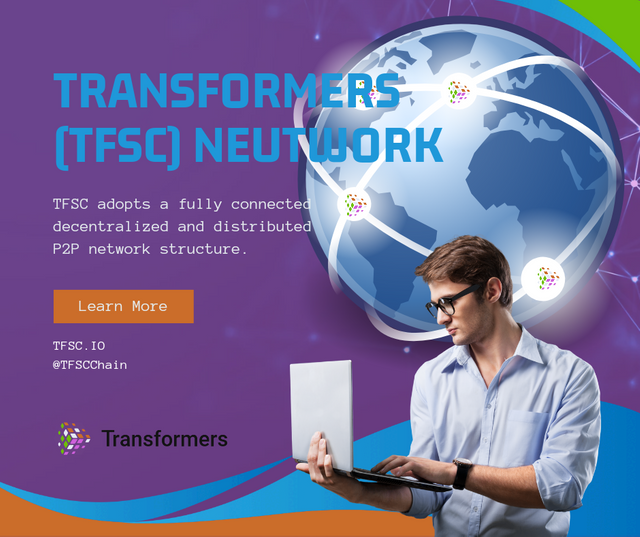
Transformers Chain (TFSC) Architecture and Network
TFSC is a fully connected decentralized and distributed P2P network structure. All nodes in the TFSC network are equal, acting as both clients and servers. This design choice ensures that the network is highly reliable and scalable.
Network Structure
The TFSC network consists of a set of nodes that are connected to each other in a peer-to-peer (P2P) fashion. This means that each node is directly connected to every other node in the network. This type of network structure is very robust and resilient to failures, as any node can take over the duties of another node if it goes offline.
Node Characteristics
All nodes in the TFSC network possess the following characteristics:
Archiving: Nodes store the complete history of the blockchain, including all blocks and transactions. This allows nodes to validate new blocks and transactions, and to respond to queries about the state of the blockchain.
Validation: Nodes validate new blocks and transactions to ensure that they are valid and comply with the TFSC protocol.
Broadcast: Nodes broadcast new blocks and transactions to all other nodes in the network. This helps to ensure that the network is synchronized and that all nodes have the same view of the blockchain.
Synchronization: New nodes that join the network synchronize with existing nodes to obtain the latest copy of the blockchain.
Heartbeat: Nodes send periodic heartbeats to other nodes to verify that they are still online.
Interface: Nodes provide an open query interface to allow other nodes and applications to query the state of the blockchain.
Node Identification and Authentication
Each node in the TFSC network is identified by a unique ID. This ID is used to verify the authenticity of nodes and to prevent malicious nodes from participating in the network.
To identify and authenticate nodes, TFSC uses a node list. The node list is a list of all known nodes in the network, along with their corresponding IDs. To join the TFSC network, a new node must first obtain the node list. Once the new node has the node list, it can connect to other nodes and begin participating in the network.
Block Verification and Generation
To generate a new block, a node must first be selected as the block proposer. Block proposers are selected at random using a discrete random function. This ensures that the block selection process is fair and that all nodes have an equal chance of being selected.
Once a node has been selected as the block proposer, it collects all of the pending transactions from the network and assembles them into a new block. The block proposer then validates the block to ensure that it is valid and complies with the TFSC protocol.
Once the block has been validated, the block proposer broadcasts it to all other nodes in the network. All other nodes then validate the block. If a majority of nodes validate the block, then it is added to the blockchain.
Tolerance Interval for Malicious Nodes
The TFSC network is designed to be tolerant of a certain percentage of malicious nodes. This is achieved by using a number of different techniques, including:
Full connectivity: The fact that all nodes in the TFSC network are fully connected makes it difficult for malicious nodes to collude and attack the network.
Random block selection: The random selection of block proposers helps to prevent malicious nodes from controlling the block generation process.
Majority rule: The fact that a majority of nodes must validate a block before it is added to the blockchain helps to prevent malicious nodes from adding invalid blocks to the blockchain.
Benefits of the TFSC Architecture
The TFSC architecture offers a number of benefits, including:
High throughput: The TFSC network is capable of processing a large number of transactions per second.
High reliability: The TFSC network is highly reliable and resilient to failures.
High security: The TFSC network is highly secure and resistant to attacks.
Scalability: The TFSC network is scalable and can be easily expanded to support a larger number of nodes.
Conclusion
The TFSC network is a well-designed and innovative blockchain network that offers a number of advantages over other blockchain networks. The TFSC architecture is fully connected, decentralized, and distributed. This architecture makes the TFSC network highly reliable, scalable, and secure.
The TFSC network is still under development, but it has the potential to become a leading blockchain platform for a wide range of applications.